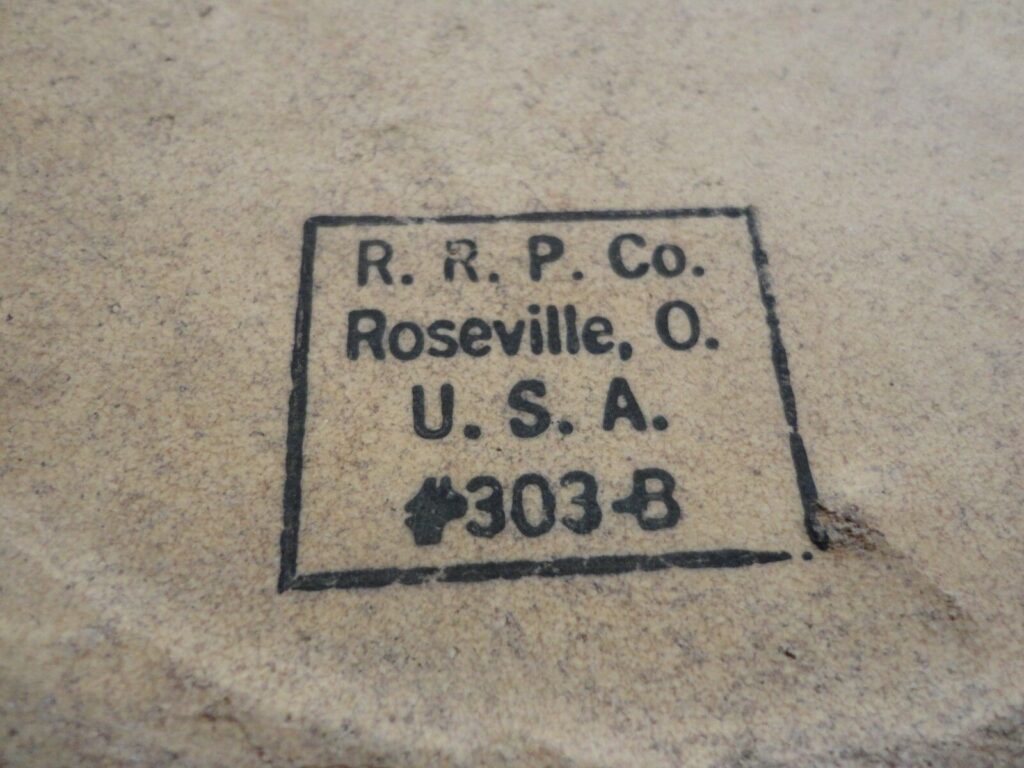
The Roseville Pottery was incorporated in 1892 in Roseville, Ohio, but they had been producing stoneware since 1890 when they purchased an old J.B. Owens Pottery factory. In 1895 they purchased the Midland Pottery, and began producing large amounts of artistic garden accessories. Even today there is a great demand for the jardinieres of this period, and they are quite rare. From 1896 through about 1900 they created and marketed their so-called “Vase Assortments”, a line of relief-molded French-inspired majolica vases. These were used as premium givaways at grocery stores and are very difficult to locate today. This represented their first art pottery line, and over 100 other lines would follow.
In 1898 Roseville Pottery purchased the Clark Stoneware Company and began operations in Zanesville, Ohio. Although the Zanesville plant produced purely utilitarian painted ware, it was quite successful. With the hiring of Ross Purdy in 1900, Rozane was produced, which was their standard glaze slip-decorated pottery. Artists were hired to hand-paint the wares with designs of flowers, animals and people. Today, some of the most sought after pieces are those painted with dogs or Native Americans. It is worth noting that the late entry of Roseville into the production of underglaze-painted brownware made them the last manufacturer to do so, at a time when the tastes of the purchasing public had already moved on. The other major companies were already winding down those products in favor new fresher designs and glazes. Also in 1900, John Herald was hired as a designer and art director.
The transformative effect of the 1904 St. Louis Exhibition on Roseville Pottery should not be understated. For the first time, the Arts Department allowed exhibitions and prizes for appled arts, and this included pottery. All of Roseville’s submissions to the applied arts competition were rejected because they “did not meet the requirements of the jury”. Their offerings of underslip decorated Rozane and Azurean were considered passe’ and out of touch with the new arts and crafts movement. Roseville then created an exhibition for the Manufacturing Palace instead to showcase the process for creating works of pottery rather than skip the fair altogether. However, the entries from Teco and Grueby spurred the development of the Roseville Matt Green, Chloron, and Egypto, and the Dedham “Twin Stars of Chelsea” Sang-de-Boeuf vases (which took the grand prize) inspired them to create the Mongol line, all in 1905. The lessons learned at the Exposition brought greater strength and diversity to the product lines of the company, and added arts and crafts to their resume.
In 1904, Frederick Hurton Rhead was recruited as the Art Director, and he held that position for only four years. But during that time he created art lines that are among the most difficult to find and highly-sought by collectors. He first tried to work with the Majolica glazes with the Cremo line, but after the 1904 Exhibition he expanded with the creation of the many Rozane lines. Of particular note is the famous Della Robbia, a response to work being done by the Owens Pottery Company.
In 1908 Harry Rhead succeeded his brother as Art Director. In an era where hand-decorated wares were becoming unpopular and unprofitable, Harry began in earnest to create less labor-intensive lines. He was responsible for the creation of the famous Donatello line, which was produced for at least ten years. They sold over 100 shapes of Donatello and the line made the Roseville Pottery successful and profitable.
Everything changed in 1918 when Frank Ferrell became the Art Director. He would come to be responsible for every shape and form created by Roseville for the next thirty years, encompassing nearly 100 lines and thousands of shapes. His first line set the tone for the future, the Sylvan pattern featured tree bark, with leaves throughout. Wildlife and hunting scenes occasionally decorated the pieces, making it quite popular with rural customers. Frank quickly followed up with the Vista pattern, and then released the first of the floral-themed patterns, Dogwood. These themed lines would become an instantly-recognizable hallmark of Roseville Pottery for decades to follow.
In 1928, Frank created the famous Futura line, featuring a wide variety of art deco designs. Even today Futura remains unique among American art pottery as the epitome of art deco design and style. Several pieces of this line such as the Tank and the Chinese Bronze are extremely rare and can command over $10,000 at auction. These and the 1926 works by Reuben Haley of Muncie Pottery remain standouts of the American Art Deco period.
In 1935, Frank designed what became the highest selling art pottery line of all time: The Pinecone line. This line was credited with saving the company from bankruptcy, and is today collected by more enthusiasts than any other pattern by any company. Pinecone was produced in over 100 shapes for over a decade, and was even added to in 1947 with the Pinecone Modern line. It was hoped that a revival of the success with the Pinecone pattern would rescue the company from trying financial times.
As with all other American pottery companies, cheaper imports from Japan undermined their sales. Constantly struggling to survive, Roseville Pottery limped along until 1954, when they sold the company along with all designs and plants to New England Ceramics Company who then sold it to Franklin Potteries of Franklin, WV. In 1954, all production of Roseville Pottery stopped. Even to this day vintage Roseville Pottery is collected by thousands of people world-wide. Prices have undergone wild swings over the years, and some patterns fall into and out of style with collectors. But with a solid history and thousands of different shapes, Roseville Pottery is certain to be collected for many decades to come.
Sungguh mengagumkan! Seperti otakku menikmati cupcake kebijaksanaan. 🧁🧠 #IndosneioCupcakeKebijaksanaan
Sungguh menggugah! Seperti otakku naik roller coaster wawasan. 🎢🧠 #IndosneioSensasiWawasan
Hebat sekali! Kontennya seperti otak mendapatkan kursi VIP di konser kebijaksanaan. 🎵🧠 #IndosneioMelodiKebijaksanaan